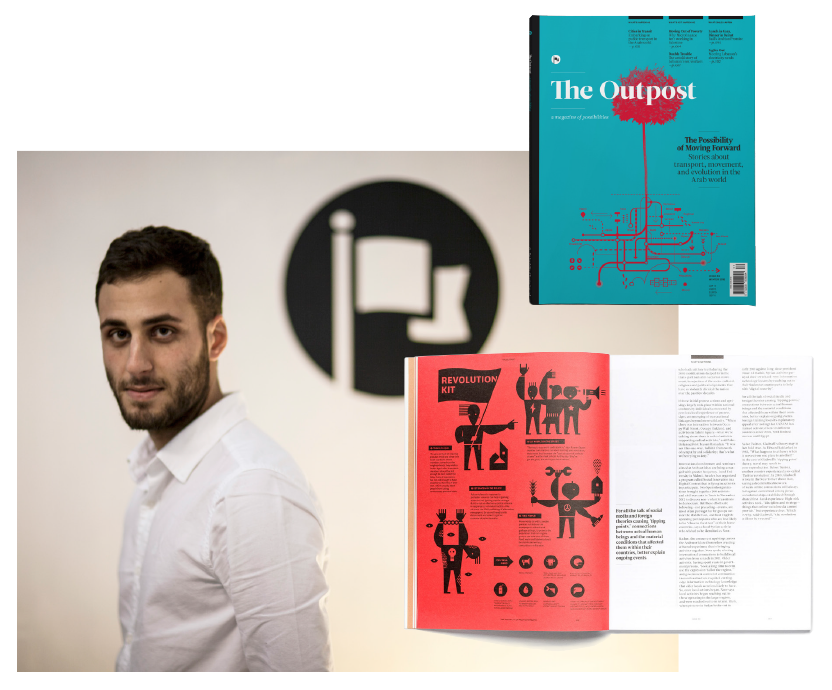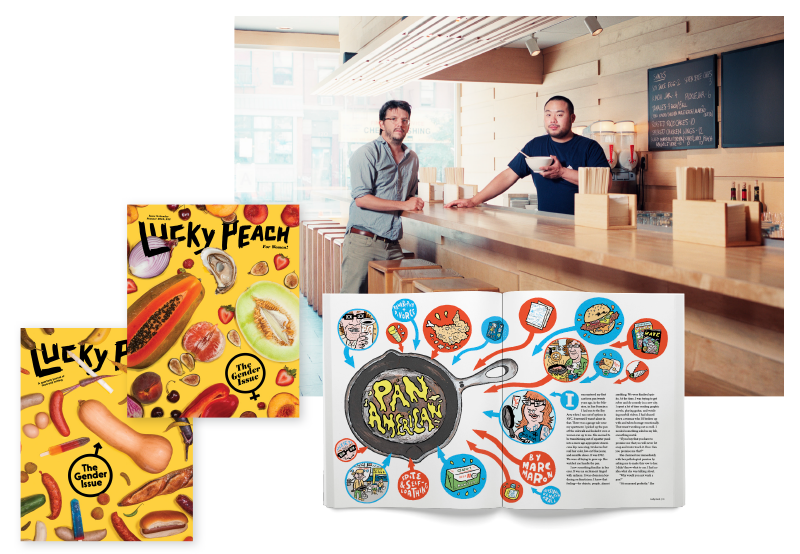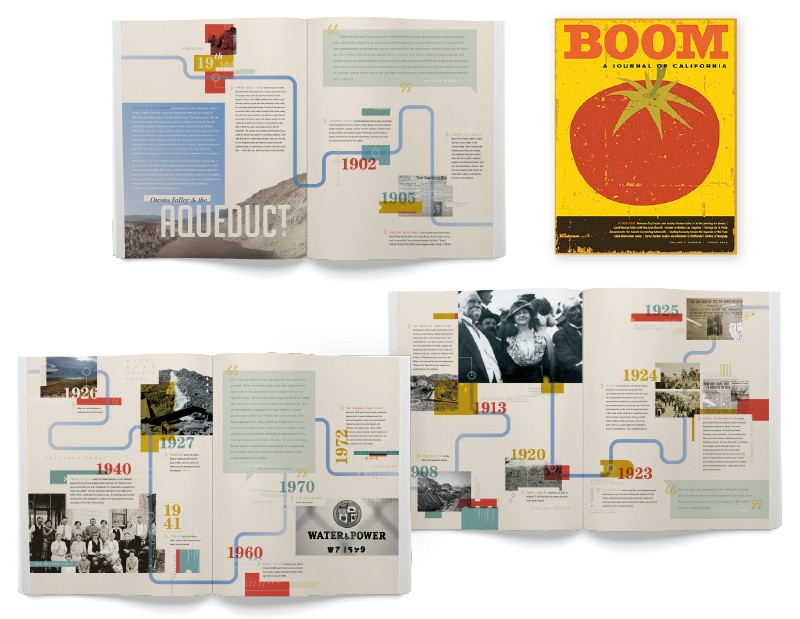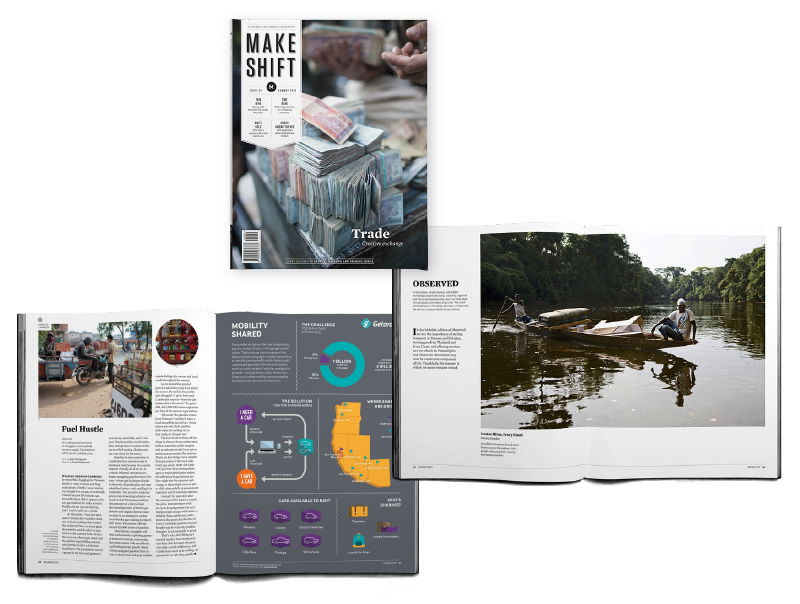In 2011, as the Arab Spring dawned, young Lebanese journalist Ibrahim Nehme yearned to play a role in the changes sweeping the Middle East. The region’s print media, he believed, didn’t measure up to the hopes of the demonstrators, who demanded democracy and fresh ideas. So Nehme resolved to start his own magazine as an outlet for the voices of the younger generation. He drained his savings, took out a loan, and asked family and friends for help. The first issue of The Outpost, a quarterly English-language print publication featuring long-form articles on the choices facing the Arab world, appeared in September 2012.
“I felt there’s an opportunity to say and make something different, make something that would become part of the revolution,” says Nehme, now 28. The idea was to create a “media voice that can capture our imagination, provide us with a space to dream, speak up, think freely, be who we are as Arab youth.”
Launching a print magazine today is courageous; some would say foolhardy. Indeed, two years in, Nehme has slowed his publishing pace from quarterly to semi-annual as he faces a constant struggle to make ends meet. But The Outpost, with a print run of about 3,000 per issue, is hardly flying solo. Worldwide, new print titles have been popping up to cover a breathtaking array of topics, from new-age agriculture (Modern Farmer) to handyman ingenuity (Makeshift) to Californian culture (The California Sunday Magazine).
And some of these publications are highlighting long-form narrative as a key selling point. Take Lucky Peach, a food magazine launched in 2011, with its award-winning features on Manhattan chef and restaurateur Wylie Dufresne and canning Southern fruits, or The Caravan, a venerable monthly that Delhi Press relaunched in 2010 after a long hiatus, with its essays on anti-Sikh violence, Hindi literature, and the full spectrum of politics and culture in between. For these publications, print still offers a powerful brand flagship as well as a source of revenue that digital platforms can supplement but not yet supplant.
Those launching print titles today are generally independent publishers, driven by passion, with little expectation of big profits. “When was the last time you heard of a [new] magazine coming from Time Inc.?” asks Samir Husni, director of the Magazine Innovation Center at the University of Mississippi. The number of launches has fallen over the years, as has magazines’ collective circulation, yet new titles keep coming. What it takes to survive, according to magazine entrepreneurs like Nehme, is targeting a clearly defined niche, finding committed backers and creative fundraising methods and, above all, a willingness to be scrappy and innovative.

THE OUTPOST Beirut journalist Ibrahim Nehme, below, founded the English-language magazine to give voice to a new generation in the Arab world
Of all the types of magazines to consider starting during the digital age, travel seems among the least likely to succeed, though Airbnb plans to launch a travel magazine called Pineapple. Digital travel tips have practically obviated the need for guidebooks, making Lonely Planet (my first writing job out of college) look almost like Baedekers. The graveyard of recently shuttered magazines includes Executive Travel, National Geographic Adventure, and Everywhere. And yet the circulation of Afar, started by Greg Sullivan and Joseph Diaz in 2009, in the teeth of the Great Recession, has grown to 250,000, a five-fold increase from its launch, and advertising—the saving grace of the travel market—has become the core financial pillar. Plus, the business is now profitable, says Sullivan.
Afar’s genius is targeting a different sort of journey, which the editors have dubbed “experiential” travel, in which the visitor interacts with a place as the locals do and sees it through their eyes. It’s not, says San Francisco-based editor in chief Julia Cosgrove, about a “vacation built around escapist fantasies of going to the beach.” Local markets, local dress, local cuisine—all are featured, often in long, narrative formats. A popular feature is Spin the Globe, in which writers are sent to random destinations; one that captured particular attention was a 2011 trip by Ryan Knighton, who is blind, to Cairo, a city rich with history but difficult to navigate. The magazine avoids “homogenizing” its writers’ voices, says Cosgrove, keeping “the stories as personal and fresh as possible, because I think that has more staying power than that sort of uni-voice that you find so often in magazines.”
Cosgrove says Afar keeps a lean staff, with just nine editors, yet puts original content on its website, largely by encouraging readers to volunteer their work. “In Paris, if you discover this really great coffee shop, you can take a photo, upload to afar.com, and describe the experience,” says Cosgrove. “People are willing and then wanting to share this information with other travelers.”
Afar’s success reflects the importance of targeting a highly specific audience. “You just have to find your audience much more explicitly now than you’ve had to,” says Dana Chinn, a media analytics strategist at the University of Southern California’s Annenberg School for Communication and Journalism. Such strategies are behind magazines like Yoga Digest, a Dallas online community that launched a national magazine in November; Good, a newly re-launched magazine focusing on people making a positive impact in the world; and Makeshift, which features acts of ingenuity from around the world.
Knowing your audience can pay off in revenue beyond subscriptions and advertising, the traditional pillars of print profit. “You’re building a community,” says Chinn, “an audience who wants to be associated with each other.” Afar derives revenue from excursions it organizes each year to destinations like Cairo, Johannesburg, and Montreal. The journeys, which cost $1,800 to $4,500, offer readers a chance to meet locals, including politicians and activists, as well as like-minded Afar readers. The trips “bring the pages of the magazine to life in a very literal way,” Cosgrove says.
The narrative niche itself can sometimes be the source of a title’s appeal, as readers seek out longer reads and deeper analysis. That’s why newsweeklies are losing relevance, according to Anant Nath, editor of The Caravan, which claims to be the first magazine in India devoted to long-form narrative. “Weekly journalism is increasingly a regurgitation of the past week’s news, which is of little relevance,” he says. “An 8,000-word profile of a politician, wherein the reporter has done some 30 to 40 interviews, presents a lot of new information,” and thus presents greater appeal to readers.
Even subjects like food, normally more associated with recipes than long-form, can lend themselves to narrative. “Twitter is awesome, but you don’t disconnect from the stress of your daily life and sink into your couch with your iPhone,” says Lucky Peach co-founder Peter Meehan. “You maintain the paranoia.”
Lucky Peach, which prints about 100,000 copies of each issue, happily publishes long pieces on trends like Malaysian street food and Christian culinary traditions in India. The magazine won five James Beard awards this year for articles on, among other topics, gay influences on cooking and the tale of a Long Island chef who blended cuisines long before it was cool, like roasted lobster flavored with soy sauce. “For us, it was like, Where are our strengths? What can we do that Bon Appétit can’t do?” Meehan says, recalling the thought process that went into starting the company. “Literature is nourishing.”

LUCKY PEACH Magazine co-founders David Chang, far right, and Peter Meehan, in Chang’s New York Momofuku noodle bar. Lucky Peach recently won five James Beard awards
Technology has brought down printing costs, but launching a magazine remains extremely expensive. For The California Sunday Magazine, which debuted this fall with a print run of more than 400,000, the magic number was $2 million. Douglas McGray, one of the co-founders, says he and his colleagues raised that amount from a mix of individual investors, some from Hollywood, publishing, and the technology world. With its emphasis on artfulness and narrative style, California Sunday carries echoes of The New Yorker, but with features on virtual reality and Blue Bottle Coffee instead of opera and Manhattan traffic. Perhaps inevitably for a publication born in the spirit of Silicon Valley, McGray doesn’t see it as a print launch. The same content that reaches readers at their homes the first Sunday of each month also appears on apps and the Web. McGray, a longtime feature journalist, and publisher Chas Edwards got the idea for California Sunday from Pop-Up Magazine, their live “magazine” of on-stage storytelling whose performances up and down the West Coast sell out in minutes. Pop-Up performs at night, a time when even people in tech-frenzied California relax and open their minds to stories. A Sunday magazine could pleasurably fill non-working hours, he reasoned, especially if people could read it however they wanted—on tablets, on phones, in print. And California had no answer to The New York Times Magazine or The New Yorker, though Pacific Standard fills some of that role. “It started to strike me as strange that with all the people in California and the West, and all the cultural, political, and business influence, that when we read big national features about [life and ideas in the West], it tends to be made in New York,” McGray says.
His backers’ money allows McGray to pay well for quality freelance work. The magazine currently has no staff writers. “We’re trying to be as lean as possible everywhere except for stories and art and the things that bring readers stories,” he says. The November issue included a long tale about the dangers and opportunities of deep-sea mining, with reporting from Papua, New Guinea. A photo essay told the story of the U.S.-Mexico border fence: one image showed a scattering of shotgun shells, another a battered soccer ball, a third the high, rust-colored border fence extending down a sandy beach.
Print has emerged as a core part of California Sunday’s business model. Rather than laboriously building a subscriber base by itself, California Sunday piggybacked on the distribution of existing newspapers. The magazine currently arrives as an insert in certain home-delivered editions of the San Francisco Chronicle, the Los Angeles Times and The Sacramento Bee, as well as San Francisco-area copies of The New York Times. Paying newspapers to distribute a magazine is far cheaper than mailing them out individually, of course, and the big initial circulation numbers also allowed California Sunday to attract high-dollar advertisers such as Lexus and Nest Labs, the Google-owned maker of smart-home hardware. “We’re trying to be nimble,” McGray says. “We’re launching with the footprint of a magazine that a big media company would produce, but we’re really influenced by the start-up culture of Silicon Valley.”
California Sunday is an outlier. For most fledgling magazines, print cannot pull in the necessary advertising dollars. Crowd-funding goes only so far, and few print magazines launch with enough subscribers to entice advertisers. Nor are many sufficiently well funded at launch to keep publishing long enough to build the circulation and reputation that attracts advertisers. (Afar is one exception; its founders, Diaz and Sullivan, as well as another investor, Ernie Garcia, have pumped $20 million into it.) The Outpost had hoped initially to generate virtually all of its revenue from advertising, but now has given that up. “We’ve literally stopped contacting or approaching advertisers,” says Nehme, the editor in chief. “It’s just discouraging and demotivating and we’re worlds apart.” The alternative is a higher price for subscribers and single issues—in effect, forcing readers to pay more for the content.

BOOM This California history and culture quarterly, based at UCLA, made a splash with an issue devoted to Los Angeles and the politics of water
Still, print often carries a cachet that digital formats do not, at least not yet, many entrepreneurs say. A print product—a copy of The Economist or The New Yorker lying on a coffee table—is a fashion statement. At Boom, a three-year-old quarterly about Californian history and culture published by the University of California Press, “the print edition is the beautiful, substantive and evocative object at the center of the whole enterprise,” says editor Jon Christensen. Boom features long essays and photographs on everything from John Muir to the San Francisco housing boom and is somewhat reminiscent of Monocle magazine, but on a California level. Last year, when Boom devoted an entire issue to the controversial history of Los Angeles’ water imports from the Sierra Nevada mountains, it generated plenty of attention despite the magazine’s modest circulation.
One of the most improbable new titles of recent years is Makeshift, a quarterly magazine devoted to the ingenuity of ordinary people. Myles Estey, editor in chief and co-founder, had been living in Liberia for a couple years and became fascinated by the informal economy there—how people built and fixed their own motorbikes, how discarded stuffed animals were cleaned and reused, how people scraped and scrapped for a living. And so, in 2011, he and a like-minded engineer, Steve Daniels, decided to start a magazine devoted to this niche.
The subject matter was so specific that they knew they wouldn’t attract many advertisers or even enough subscribers to break even, but they pushed forward nonetheless. Print was the obvious choice, according to Estey, because magazines have a special way of telling stories and building community. Makeshift has built a following by publishing long essays on subjects such as the blind hawkers in Mumbai’s train stations and how the tunnels under the border between Gaza and Egypt are built and destroyed. “It’s a lot of work,” admits Estey, who spends much of his time in Mexico City and has written about drug smuggling and film pirating. Makeshift’s editors all work other jobs, because no can yet make a full-time living from the magazine. It’s an advantage, Estey argues, because editors pull ideas from their outside lines of work.
Readers—and, just as crucially, sponsors—have responded enthusiastically. Makeshift has built its circulation to 20,000. Crowd-funding helped with the early issues, which also received support from an engineering group; subsequent sponsors have included General Electric. The magazine is now expanding into design consulting and teaching as other ways of raising revenue.

MAKESHIFT The ingenuity of ordinary people in Liberia was the impetus behind the founding of this quarterly, which markets itself via new tools, such as Magpile and Stack
It has also innovated on the distribution side, taking advantage of new digital tools that can help small publishers reach wider audiences. Single-issue copies can be purchased at Magpile, an online library and media shop that charges sellers like Makeshift a monthly fee and takes an 8 percent cut of an issue’s cover price. Publishers themselves are responsible for mailing out the magazines. Another service is U.K.-based Stack; founder and director Steve Watson buys a different magazine each month to send out to his subscribers. Watson aims for interesting, fresh titles, and Makeshift, says Estey, is in the 2015 lineup.
For these nascent titles, digital strategies diverge. Many lack an elaborate Web presence; Lucky Peach, for example, has a Tumblr presence, but mostly steers users toward its print edition (“We’re going to start a real site next year, with daily content,” says Meehan.) The Web has a faster metabolism, as Casey Caplowe, co-founder of Good magazine, puts it. “The Web is a great place for the more quick and news-responsive thing,” he says, whereas print allows for sitting back and digging into nuance.
Yet the question remains whether digital media will one day erode print so profoundly that it disappears completely. There are signs, in fact, that users are increasingly comfortable reading long-form writing on tablets and mobile devices. Earlier this year people spent more than 25 minutes reading a 6,000-word BuzzFeed story on their phones about buying a cheap home in Detroit, according to The Atlantic. The story received more than a million pageviews, with nearly half the people accessing it from mobile devices.
The venture planned by former New York Times executive editor Jill Abramson and journalist and media entrepreneur Steven Brill, which will feature mammoth long-form stories each month in digital rather than print, shows that even old media types are considering digital as a way forward for long-form journalism.
For now, though, the new print magazines are living in the moment, and hoping to expand. California Sunday, for one, has grand plans. McGray hopes to increase distribution, on apps and in print, and steer the publication toward biweekly and finally weekly frequency. “We talk around the office of not having the benefit of 100 years of history,” says McGray. “But we don’t have the burden either.”


